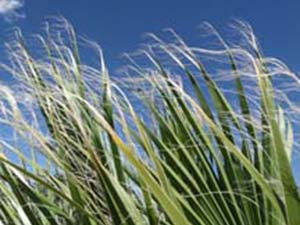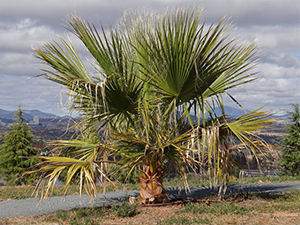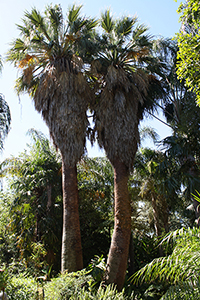Washingtonia filifera


Other common names
Desert Fan Palm, American Cotton Palm, Arizona Fan Palm. Indigenous: Maul
Origin of the species name
Washingtonia honours President George Washington (1732 - 1799), USA; filifera: from Greek, meaning thread bearing.
Family
Arecaceae
Date planted
February 2008
Lifespan
Californian Fan Palms can live up to 250 years.

General description
This is a hardy, fast-growing large palm. The leaves are up to 2 m long, bearing a green fan of 1.5-2 m long, with white, thread-like fibres between the segments. When the leaves die they bend downwards and form a skirt around the trunk. Height 20 m Spread 8m.
Natural distribution and habitat
The species is native to Southwest USA and Northwest Mexico and gives the name to Palm Springs, California where it is found in desert river habitats around spring-fed oases forming open to dense groves in moist areas.
Conservation status
It has been assessed as being near threatened with little genetic variation existing. Due to urbanisation, palm oases are disappearing, and increased agriculture has lowered ground water supplies in the remaining palm oases.
Uses
The fruit of the fan palm was eaten raw, cooked, or ground into flour for cakes by the Cahuilla tribe. In times of famine, the spongy pith in the centre was sometimes boiled and eaten and was called maul pasun or "heart of the palm". Some tribes used the long flexible leaf-stems for hunting bows. It is now widely cultivated as an ornamental tree.
Planting pattern
Straight rows radiating out from the hilltop. New rows begin as the land broadens out.
Further reading
Jones, D (1995) Palms Throughout the World. Smithsonian Books.
